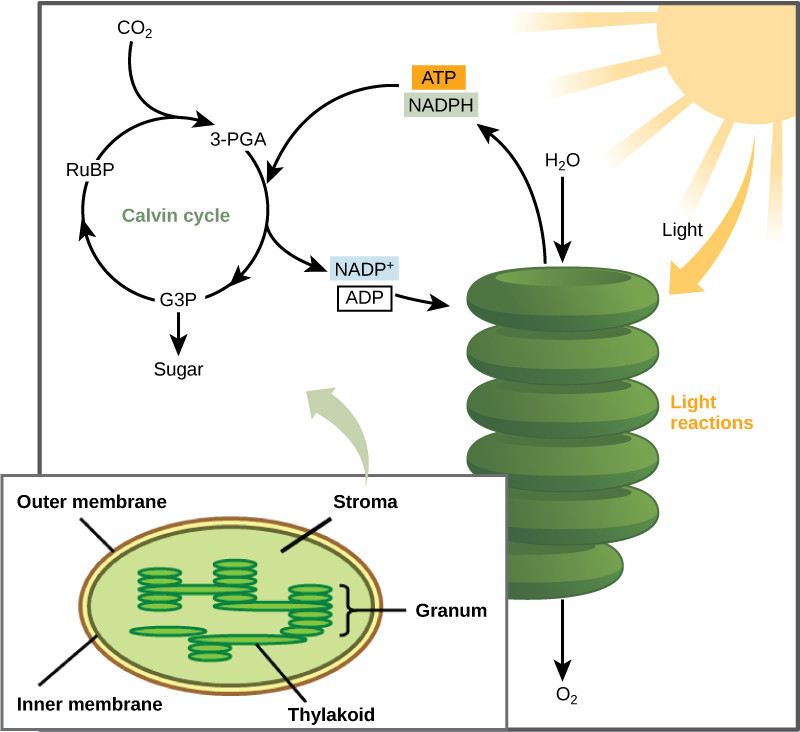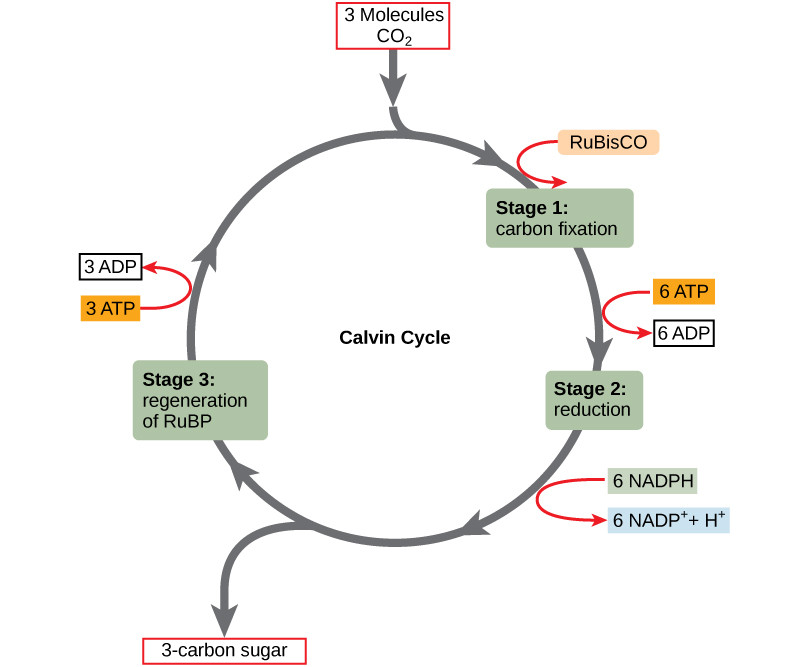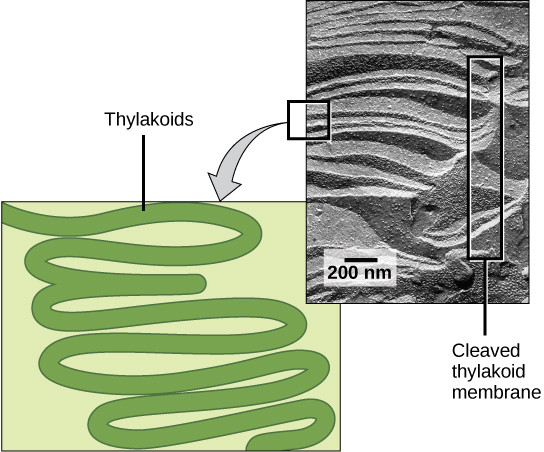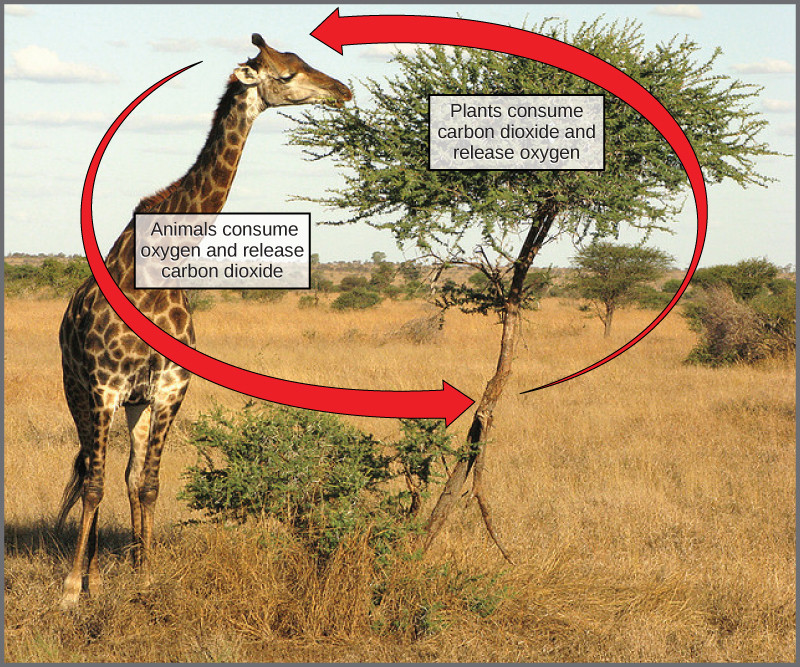Photosynthesis, the remarkable process that sustains life on Earth, converts light energy into chemical energy in the form of glucose and other carbohydrate molecules. This process is broadly divided into two stages: the light-dependent reactions and the light-independent reactions, also known as the Calvin cycle or Calvin-Benson cycle. While the light-dependent reactions capture sunlight, the Calvin cycle utilizes the energy harvested to build sugars from carbon dioxide. Understanding Where Does The Calvin Cycle Occur is crucial to grasping the intricacies of photosynthesis and the energy cycle of life.
The Chloroplast: The Primary Site of the Calvin Cycle in Plants
In plants and algae, photosynthesis takes place within specialized organelles called chloroplasts. These organelles are the powerhouses of plant cells, hosting both the light-dependent and light-independent reactions. To pinpoint where does the Calvin cycle occur within the chloroplast, we need to delve into its structure.
Chloroplasts are enclosed by a double membrane and contain internal structures called thylakoids, which are stacked into grana. The light-dependent reactions occur within the thylakoid membranes. Surrounding the thylakoids is a gel-like fluid called the stroma. This stroma is the crucial location for the Calvin cycle.
The stroma provides the necessary environment and components for the Calvin cycle to operate. It contains all the enzymes, including RuBisCO, and molecules like ribulose bisphosphate (RuBP) required for carbon fixation and sugar synthesis. The ATP and NADPH, energy-carrying molecules produced during the light-dependent reactions in the thylakoid membranes, are released into the stroma to power the Calvin cycle. Therefore, the answer to where does the Calvin cycle occur in plants is unequivocally: the stroma of the chloroplast.
 Diagram illustrating that ATP and NADPH from light reactions are used in the Calvin cycle within the stroma to produce sugar.
Diagram illustrating that ATP and NADPH from light reactions are used in the Calvin cycle within the stroma to produce sugar.
Inside the Stroma: The Calvin Cycle’s Operational Hub
Now that we’ve established that the stroma is where the Calvin cycle occurs, let’s explore how this cycle operates within this space. The Calvin cycle is a cyclical series of biochemical reactions that can be divided into three main stages:
-
Carbon Fixation: The cycle begins with carbon dioxide (CO2) entering the stroma from the atmosphere. An enzyme called RuBisCO (ribulose-1,5-bisphosphate carboxylase/oxygenase) catalyzes the reaction between CO2 and RuBP (ribulose-1,5-bisphosphate), a five-carbon molecule already present in the stroma. This reaction forms an unstable six-carbon compound that immediately breaks down into two molecules of 3-PGA (3-phosphoglycerate), a three-carbon compound. This crucial step is known as carbon fixation, as inorganic CO2 is “fixed” into organic molecules.
-
Reduction: In the reduction stage, ATP and NADPH, generated from the light-dependent reactions and present in the stroma, provide the energy and electrons needed to convert 3-PGA into G3P (glyceraldehyde-3-phosphate), another three-carbon compound. This conversion involves a reduction reaction, where electrons are gained. Some G3P molecules are then used to synthesize glucose and other carbohydrates within the stroma or transported out of the chloroplast to other parts of the plant cell.
-
Regeneration: For the Calvin cycle to continue, RuBP, the initial CO2 acceptor, needs to be regenerated. The remaining G3P molecules are used in a series of reactions, also powered by ATP from the light-dependent reactions, to regenerate RuBP. This regeneration ensures that the cycle can continue to fix more CO2.
This intricate cycle, occurring entirely within the stroma, effectively uses the energy from sunlight (via ATP and NADPH) to transform inorganic carbon dioxide into energy-rich carbohydrate molecules.
 Diagram showing the three stages of the Calvin cycle: carbon fixation, reduction, and regeneration, all taking place in the stroma.
Diagram showing the three stages of the Calvin cycle: carbon fixation, reduction, and regeneration, all taking place in the stroma.
Calvin Cycle in Prokaryotes: A Different Locale
While chloroplasts are the sites of photosynthesis in plants and algae, prokaryotic organisms like cyanobacteria do not possess membrane-bound organelles like chloroplasts. So, where does the Calvin cycle occur in these organisms?
In prokaryotic photosynthetic bacteria, including cyanobacteria, the entire process of photosynthesis takes place within the cytoplasm. These organisms have infoldings of their plasma membrane that function similarly to thylakoids in chloroplasts, housing the chlorophyll and the machinery for light-dependent reactions. However, the Calvin cycle in prokaryotes occurs in the cytoplasm, the same fluid-filled space where other cellular processes take place.
Therefore, while the stroma is where the Calvin cycle occurs in eukaryotes, the cytoplasm serves as the location for the Calvin cycle in photosynthetic prokaryotes. This highlights the fundamental nature of the Calvin cycle as a core metabolic pathway, adapted to function in different cellular environments.
 Illustration and micrograph showing infolded plasma membranes in a prokaryotic cell, indicating the location of photosynthesis, while the Calvin cycle occurs in the cytoplasm.
Illustration and micrograph showing infolded plasma membranes in a prokaryotic cell, indicating the location of photosynthesis, while the Calvin cycle occurs in the cytoplasm.
The Broader Context: Calvin Cycle and the Energy Cycle
Understanding where does the Calvin cycle occur is not just about cellular location; it’s also about understanding its role in the broader energy cycle of life. The Calvin cycle is intrinsically linked to both photosynthesis and cellular respiration, forming a balanced biological cycle.
Photosynthesis, with the Calvin cycle at its heart, captures light energy and stores it in carbohydrate molecules. These carbohydrates serve as a primary source of energy for most life forms. Cellular respiration, on the other hand, breaks down these carbohydrates, releasing the stored energy for cellular activities.
Interestingly, the overall chemical reaction of photosynthesis is the reverse of cellular respiration. Photosynthesis uses carbon dioxide and water to produce glucose and oxygen, while cellular respiration uses oxygen and glucose to produce carbon dioxide and water. This reciprocal relationship underscores the cyclical nature of matter and energy in ecosystems.
The Calvin cycle, by fixing atmospheric carbon dioxide into sugars, plays a critical role in the global carbon cycle. It removes carbon dioxide from the atmosphere, mitigating climate change, and provides the foundation for food chains that sustain life on Earth. The location of the Calvin cycle, whether in the stroma of a chloroplast or the cytoplasm of a prokaryote, is therefore central to the flow of energy and matter in the biosphere.
 Photograph of a giraffe eating leaves, illustrating the carbon cycle where plants use CO2 and release O2, and animals use O2 and release CO2.
Photograph of a giraffe eating leaves, illustrating the carbon cycle where plants use CO2 and release O2, and animals use O2 and release CO2.
Conclusion
In summary, where does the Calvin cycle occur? The answer depends on the organism. In plants and algae (eukaryotes), the Calvin cycle takes place in the stroma of the chloroplast. In prokaryotic organisms like cyanobacteria, the Calvin cycle occurs in the cytoplasm. Regardless of the specific location, the Calvin cycle’s fundamental function remains the same: to use the energy captured during the light-dependent reactions of photosynthesis to fix carbon dioxide and synthesize carbohydrates. This remarkable cycle is not only essential for plant life but also forms the basis of energy for nearly all ecosystems on our planet.

